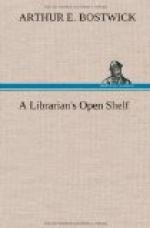The various attempts to standardize type-sizes and to adopt a suitable notation for them have been limited hitherto to the sizes of the type-body and bear only indirectly on the size of the actual letter. More or less arbitrary names—such as minion, bourgeois, brevier, and nonpareil,—were formerly used; but what is called the point-system is now practically universal, although its unit, the “point,” is not everywhere the same. Roughly speaking, a point is one-seventy-second of an inch, so that in three-point type, for example, the thickness of the type-body, from the top to the bottom of the letter on its face, is one-twenty-fourth of an inch. But on this type-body the face may be large or small—although of course, it cannot be larger than the body,—and the size of the letters called by precisely the same name in the point notation may vary within pretty wide limits. There is no accepted notation for the size of the letters themselves, and this fact tells, more eloquently than words, that the present sizes of type are standardized and defined for compositors only, not for readers, and still less for scientific students of the effect upon the readers’ eyes of different arrangements of the printed page.
What seems to have been the first attempt to define sizes of type suitable for school grades was made fifteen years ago by Mr Edward R. Shaw in his “School Hygiene”; he advocates sizes from eighteen-point in the first year to twelve-point for the fourth. “Principals, teachers, and school superintendents,” he says, “should possess a millimetre measure and a magnifying glass, and should subject every book presented for their examination to a test to determine whether the size of the letters and the width of the leading are of such dimensions as will not prove injurious to the eyes of children.” To this list, librarians might be well added—not to speak of authors, editors, and publishers. In a subsequent part of his chapter on “Eyesight and Hearing,” from which the above sentence is quoted, appears a test of illumination suggested by “The Medical Record” of Strasburg, which may serve as a “horrid example” in some such way as did the drunken brother who accompanied the temperance lecturer. According to this authority, if a pupil is unable to read diamond type—four-and-one-half-point—“at twelve-inch distance and without strain,” the illumination is dangerously low. The adult who tries the experiment will be inclined to conclude that whatever the illumination, the proper place for the man who uses diamond type for any purpose is the penitentiary.




